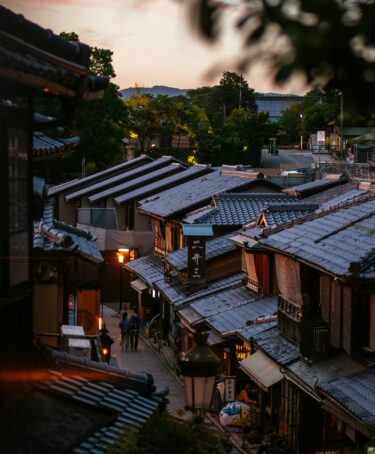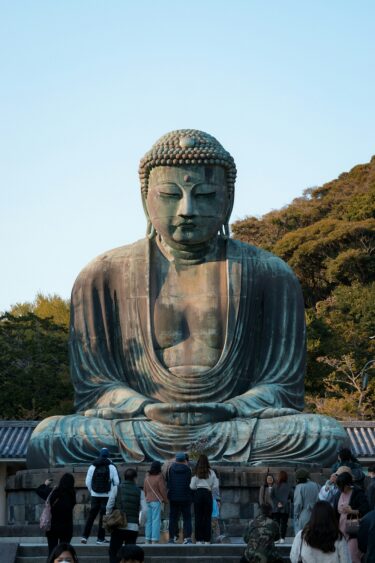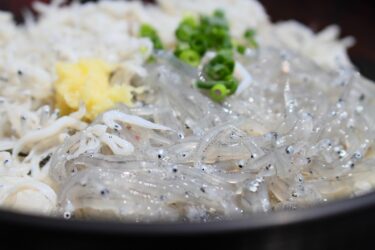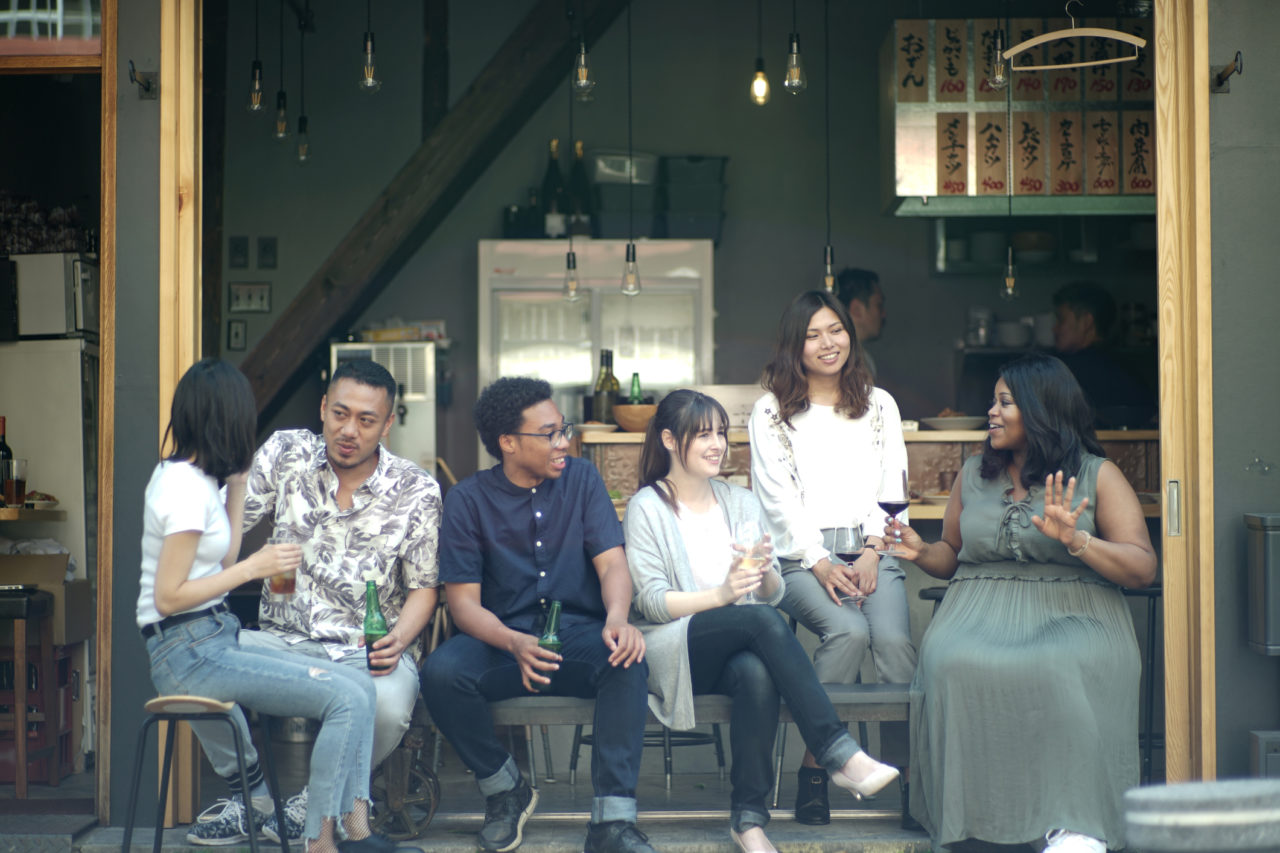
京都を訪れる外国人観光客は、寺社仏閣だけでなく、日本の伝統的な食文化にも強い関心を持っています。
「どこでおいしいものが食べられますか?」と聞かれたとき、
京都ならではの食の魅力を英語で伝えられたら素敵ですよね。
この記事では、京都の「おいしいもの」を外国人観光客に紹介する際に使える英語フレーズをご紹介します。
和食の奥深さや京都ならではの食文化を伝える表現を身につけましょう。
*京都を英語で道案内はこちら。
目次
京都の伝統食を紹介する基本フレーズ
京都の食文化の特徴を簡潔に説明できる表現です。
- “Kyoto cuisine, called ‘Kyo-ryori’, is known for its delicate flavors that highlight the natural taste of seasonal ingredients.”
(京都料理は「京料理」と呼ばれ、季節の食材の自然な味わいを引き立てる繊細な風味で知られています) - “Traditional Kyoto food tends to be less salty and more subtle than other regional Japanese cuisines, reflecting its origins as imperial court cuisine.”
(伝統的な京都の食べ物は、他の地域の日本料理よりも塩分が控えめでより繊細な味わいがあり、宮廷料理としての起源を反映しています) - “Many Kyoto specialties are vegetarian Buddhist temple foods called ‘Shojin Ryori’, which don’t use meat, fish, or strong-smelling vegetables like garlic or onions.”
(京都の特産品の多くは「精進料理」と呼ばれる菜食主義の仏教寺院料理で、肉、魚、またはニンニクやタマネギのような強い香りの野菜を使用していません)
京都名物料理を説明する英語表現
湯葉(ゆば)を紹介する
- “Yuba is delicate layers of tofu skin that form on the surface when making tofu. In Kyoto, it’s served in many ways—fresh, dried, rolled, or in soups. It has a subtle, creamy flavor that absorbs the dashi broth beautifully.”
(湯葉は豆腐を作る際に表面にできる繊細な豆腐の皮の層です。京都では、新鮮なまま、乾燥させたもの、巻いたもの、またはスープの中など、さまざまな方法で提供されます。微妙でクリーミーな風味があり、出汁の味を美しく吸収します)
京漬物を紹介する
- “Kyoto pickles, or ‘Kyo-tsukemono’, are an essential part of traditional meals. Unlike pickles in Western countries, these are made with salt, rice bran, or sake lees, creating unique flavors. The most famous is ‘Shibazuke’—eggplant and cucumber pickled with red shiso leaves, giving them a beautiful purple color.”
(京都の漬物、または「京漬物」は、伝統的な食事に欠かせない部分です。西洋諸国の漬物とは異なり、塩、米ぬか、または酒粕で作られ、独特の風味を生み出します。最も有名なのは「しば漬け」で、赤じその葉で漬けたナスときゅうりで、美しい紫色をしています)
おばんざいを紹介する
- “Obanzai refers to Kyoto’s traditional home-style cooking. These are simple, healthy side dishes made with local, seasonal vegetables. They represent the everyday food of Kyoto households rather than fancy restaurant cuisine.”
(おばんざいは京都の伝統的な家庭料理を指します。地元の季節の野菜で作られたシンプルで健康的な副菜です。豪華なレストラン料理というよりも、京都の家庭の日常的な食事を代表しています)
八つ橋・生八つ橋を紹介する
- “Yatsuhashi are cinnamon-flavored cookies shaped like curved bridges—a popular Kyoto souvenir. The soft version, ‘nama-yatsuhashi’, is like a sweet mochi filled with red bean paste or other fillings like matcha or strawberry. The name comes from the shape that resembles the bridges in traditional Japanese gardens.”
(八つ橋は曲がった橋の形をしたシナモン風味のクッキーで、京都の人気のお土産です。柔らかいバージョンの「生八つ橋」は、餡や抹茶、イチゴなどの他の具材が入った甘い餅のようなものです。名前は日本の伝統的な庭園にある橋に似た形に由来しています)
京都の食事処を紹介する英語表現
町家カフェ
- “Kyoto has many cafés inside renovated ‘machiya’—traditional wooden townhouses. You can enjoy modern drinks and desserts while experiencing the atmosphere of old Kyoto architecture. The one in Ninenzaka near Kiyomizu Temple has a beautiful garden view.”
(京都には、改装された「町家」—伝統的な木造の町家—の中にあるカフェがたくさんあります。古い京都の建築の雰囲気を味わいながら、モダンな飲み物やデザートを楽しむことができます。清水寺近くの二年坂にあるこのカフェは、美しい庭園の眺めがあります)
錦市場
- “Nishiki Market is known as ‘Kyoto’s Kitchen’—a narrow shopping street with over 100 food shops and stalls. It’s perfect for trying small food samples as you walk through. You can find everything from fresh seafood and Kyoto vegetables to traditional sweets and pickles. I recommend the soy milk donuts and the grilled fish on skewers.”
(錦市場は「京都の台所」として知られており、100以上の食料品店や屋台がある細い商店街です。歩きながら小さな食べ物のサンプルを試すのに最適です。新鮮な魚介類や京野菜から伝統的なお菓子や漬物まで、あらゆるものが見つかります。豆乳ドーナツや串に刺した焼き魚がおすすめです)
鴨川沿いのレストラン
- “For a special dining experience, I recommend restaurants along the Kamogawa River. In summer, many places offer ‘kawayuka’ dining—outdoor platforms built over the river where you can enjoy meals with a cooling river breeze. It’s a traditional way to escape the summer heat in Kyoto.”
(特別な食事体験には、鴨川沿いのレストランをお勧めします。夏には、多くの場所が「川床」ダイニングを提供しています—川の上に建てられた屋外のプラットフォームで、涼しい川風とともに食事を楽しむことができます。これは京都の夏の暑さから逃れる伝統的な方法です)
食事のマナーを説明する英語表現
外国人観光客に日本の食事マナーを伝える際に役立つ表現です。
- “In traditional Kyoto restaurants, it’s customary to say ‘itadakimasu’ before eating and ‘gochisosama deshita’ after finishing your meal. These phrases express gratitude for the food.”
(京都の伝統的なレストランでは、食事の前に「いただきます」、食事が終わった後に「ごちそうさまでした」と言うのが習慣です。これらのフレーズは食べ物への感謝の気持ちを表しています) - “When eating in a traditional Japanese restaurant, it’s polite to use the oshibori (hot towel) to clean your hands before eating, but not your face or neck.”
(伝統的な日本料理店で食事をする際には、食事の前にお手拭い(温かいタオル)で手を清めるのが礼儀正しいとされていますが、顔や首を拭くのはマナー違反です) - “If you’re trying Kyoto’s tofu cuisine, it’s best enjoyed with a small amount of the provided condiments like soy sauce, grated ginger, or green onions. The idea is to enhance, not overpower, the delicate flavor of the tofu.”
(京都の豆腐料理を試す場合、提供された醤油、すりおろし生姜、または青ネギなどの調味料を少量使うのが最適です。豆腐の繊細な風味を引き立てるのであって、強く主張させないという考え方です)
お土産を推薦する英語表現
京都の食べ物のお土産を推薦する時に使える表現です。
- “If you want to bring home a taste of Kyoto, I recommend ‘yatsuhashi’ cookies—they travel well and last for weeks. The individually wrapped nama-yatsuhashi are best if you’ll be eating them within a few days.”
(京都の味を持ち帰りたい場合は、「八つ橋」クッキーをお勧めします—持ち運びに適しており、数週間持ちます。個別に包装された生八つ橋は、数日以内に食べる場合は最適です) - “For tea lovers, Uji matcha from just outside Kyoto is world-famous. The high-quality green tea powder makes a great souvenir, and many shops offer beautiful gift packaging.”
(お茶好きの方には、京都のすぐ外にある宇治抹茶が世界的に有名です。高品質の緑茶パウダーは素晴らしいお土産になり、多くの店が美しいギフトパッケージを提供しています) - “Tsukemono pickles in vacuum-sealed packages can last for several weeks and make unique souvenirs. The colorful Shibazuke pickles are particularly popular with foreign visitors.”
(真空パックされた漬物は数週間持ち、ユニークなお土産になります。カラフルなしば漬けは特に外国人観光客に人気があります)
まとめ
京都の食文化は、その繊細さと季節感、そして長い歴史を反映した奥深いものです。外国人観光客に京都の「おいしいもの」を紹介する際は、単に「美味しい」と言うだけでなく、その背景にある文化や歴史も一緒に伝えられるとより理解が深まります。
この記事で紹介した英語フレーズを使いながら、京都の食の魅力を世界中からの旅行者に伝えてみましょう。言葉の壁を越えた食文化の交流は、きっと忘れられない思い出になるはずです。










